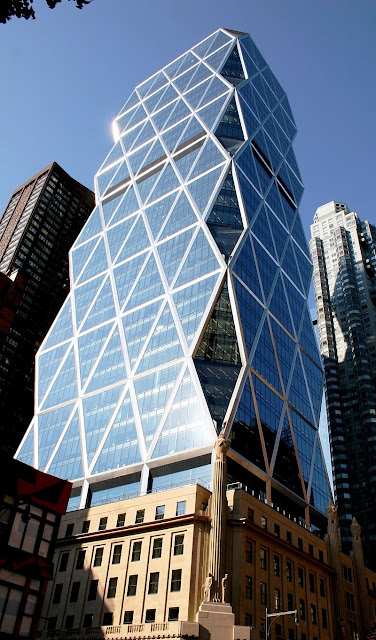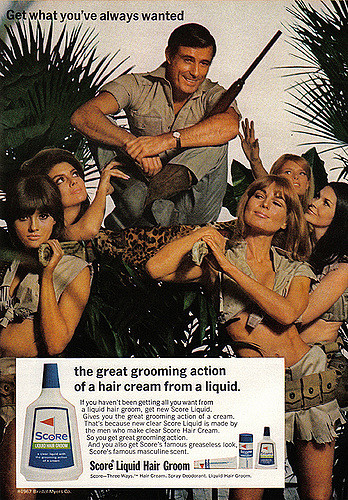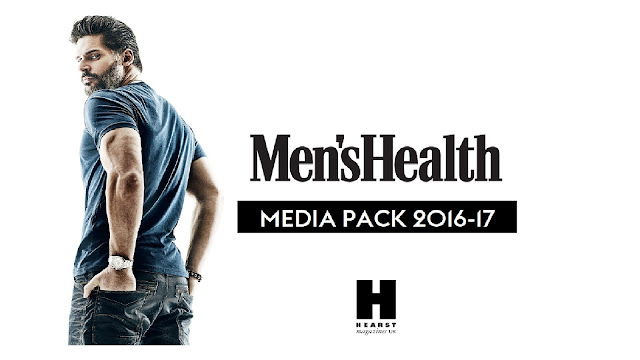Men's Health - Industries case study
Hearst publishing
 |
| Hearst Tower in Manhattan, New York City |
1) Hearst UK is part of Hearst Communications. What is Hearst Communications and where is it based?
Hearst Communications (AKA Hearst), is an American mass media and business information conglomerate based in New York City. It was founded in 1887, 131 years ago, by William Randolph Hearst.
2) What media industries and brands make up the Hearst Communications conglomerate?
There are 21 brands that make up the Hearst Communications conglomerate. These include some of the most successful brands, including ELLE, Harper’s Bazaar, Cosmopolitan, Men's Health and Good Housekeeping.
3) What was the global revenue for Hearst Communications (in dollars) for the most recent year on record?
$10.8 billion (2016)
4) Focusing on Hearst UK, what other magazine brands are part of Hearst UK publishing? How many UK people do they reach in print and online?
There are many other magazine brands that make up Hearst UK. These include: Good Living, Best, Cosmopolitan, Country living, Digital Spy, Elle, Elle Decoration, Esquire, Good Housekeeping, Good Housekeeping Institute, Harper's Bazzar, House Beautiful, Inside Soap, Men's Health, Net Doctor, Prima, Real People, Red, Reveal, Runner's World, Town & Country and Women's Health.
Hearst Communications reach over one in three UK women and one in four UK men every month. They sell over four million magazines a month and have 17 million UK digital unique users, reaching 22 million fans and followers through social media platforms, including Snapchat Discover.
Read this Campaign interview with Hearst UK CEO James Wildman.
5) What is James Wildman's plan for Hearst UK?
His aim is to grow share in print to overtake the decline. He plans to accelerate growth in digital, diversify revenues through events and partnerships, and look at acquisitions.
6) What percentage ad decline are consumer magazines facing?
Consumer magazines are facing ad declines of more than 10% this year. This is due to the fact that money is flowing to Google and Facebook, and online influencers, such as YouTubers, are chipping away at print brands.
7) What does Wildman think about premium content and paywalls?
Wildman believes that they should start charging for premium content ("the most extraordinary recipe archive" at Good Housekeeping is one example). However, no paywalls have been planned yet.
8) How has Hearst used diversification to grow the business?
Hearst runs about 100 events a year for readers of their magazines. Events such as Esquire Town House are popular and Wildman pans to focus more on them. Hearst also wants to make more of Good Housekeeping’s respected accreditation team, which tests products. Its endorsements can drive sales for products such as Procter & Gamble’s Olay, which subsequently led to the magazine taking part in a TV ad.
Read this Hearst UK press release for their late 2017 ABC figures.
9) Is Men's Health increasing or decreasing in circulation?
Men's Health is increasing in circulation. For the period Jul-Dec 2017, the magazine increased circulation by 1% (period-on-period), allowing it to remain the number one monthly Men’s Lifestyle magazine.
10) What explanation is provided by Hearst for the success of their magazines in a tough print market?
Hearst explains that they are able to keep their success in a tough print market by utilising optional analysis in their ABC certificates to demonstrate how each brand is targeting new readers using innovative routes to market. By doing this, they are able to distribute their magazines right into the hands of their target audience. This is done through gyms, cinemas, shopping centres and through partner marketing programmes. Independent research carried out on behalf of Hearst in 2017 shows engagement levels among consumers who receive dynamically distributed copies is just as high as those readers who paid for a copy of their magazine.
The impact of digital media on the print magazines industry
Read this BBC website feature on the print magazine industry and then this Guardian feature on the demise of NME magazine and print magazines in general.
1) Why are traditional print magazines struggling?
Traditional print magazines are struggling to survive because of the internet. The internet has resulted in the birth of social media apps (such as Instagram, Twitter and Snapchat) and, therefore, threatened the existence of print magazines. It is difficult to create a print magazine that audiences would want to pay for when there are so many more places that they can obtain the information from for free.
2) What genre of magazines is currently bucking the trend and increasing sales? Why is this?
News and current affairs magazines are becoming more popular, such as The Economist and The Spectator. Their sales have increased dramatically, for example-
- Prospect sales went up 37.2% to 44,545
- The Spectator - up 11.3% to 85,429
- Private Eye - up 8.6% year on year to 249,927 per issue
- The Economist - up 5% to 248,196
This is probably due to the fact that people are no longer interested in petty news (such as celebrity gossip) that is not going to benefit their lives in any way. They would rather spend time educating themselves on current affairs. This is especially true in the last few years it has been an extraordinarily frantic news agenda - with Brexit, Trump, a snap election, terror attacks and Grenfell Tower as a few examples.
3) In contrast, what magazine genres are struggling? Give examples of magazines that have declined or stopped printing altogether.Celebrity, gossip and fashion publications are still struggling. Their sales have decreased dramatically over the past year. Examples include-
- Look - weekly sales down 35% year on year to 59,390
- Now - down 20.8% to 86,838
- Closer - down 19.8% to 196,126
- Heat - down 16.6% to 120,175
- Grazia - down 13.4% to 110,031
- Vanity Fair (10%)
- Marie Claire (6%)
- OK! (3.5%)
- Vogue (3%)
NME is one magazine that has stopped printing altogether. Even Glamour, an extremely popular magazine at one point, had to halt its printing for a month due to lack of sales.
4) Look at the Guardian article in detail. What statistics are provided to demonstrate the decline in the print magazines industry between 2010 and 2017? What about the percentage decline from 2000?Between 2010-2017, Sales of the top 100 actively purchased print titles in the UK – those that readers buy or subscribe to – fell by 42% from 23.8m to 13.9m.
Since the start of the internet era in 2000, the decline is 55% from 30.8m, according to the Audit Bureau of Circulations.
5) What percentage of ad revenue is taken by Google and Facebook?
Google and Facebook account for 65% of the £4.7bn UK digital display ad market. They take about 90% of all new spend.
6) What strategies can magazine publishers use to remain in business in the digital age?
Magazine publishers need to create something unique that their readers will be willing to pay for. Wildman says 'for magazines to survive they must build a brand beyond the core print publication.' They must also find ways to diversify. For example, create events like the Harper’s Bazaar [event] or create products to be sold, like the Men's Health gym equipment range in Argos.
7) Why does the Hearst UK CEO James Wildman suggest that the magazine industry is not dead?
He suggests that it is not dead because many of the Hearst magazines are still doing very well. “We sell nearly 5m a month, that’s hardly dead, and we have 20 million unique UK users online a month, and more than double that on social media." They are also gaining a lot of revenue through their other products (events, food, gym, etc.)
8) What examples from the Guardian article are provided to demonstrate how magazines are finding new revenue streams? What is the Men's Health branding used for?
Hosting brand events. Men's Health has made its own gym equipment range.
9) What signs for optimism might there be for traditional magazine brands?
Traditional magazine brands will be alright as long as they provide their readers with quality context and are a trustworthy brand. Wildman says“With issues such as fake news, we are seeing the pendulum swing back because of two things: trust and context...Now we are seeing readers and advertisers leaning back towards trusted brands.”
10) How does Men's Health fit into this picture? Why do you think Men's Health has remained successful in the digital age? Do you think Men's Health will continue to publish for many years to come? Why?
I think MH has remained successful in the digital age because of the quality of its content and the trust it has maintained in its audience. MH provides its readers with content backed up by much research and scientific evidence which makes it reliable. Furthermore, they provide a wide range of content, from exercise routines to healthy recipes, to fashion advice and talk concerning mental illness. Therefore, I think they will continue to publish for many years to come because they are a very well established brand.
The Men's Health website and social media
Visit the Men's Health website, Twitter feed and Instagram. You may need to complete this part of the case study at home if it is blocked in school.
1) What similarities do you notice between the website and the print edition of the magazine?
The font used is the same and the 'Men'sHealth' logo that is present in all print magazine editions is also on the website in the top right corner. Also, the colour scheme is quite similar- black, red, whites and reds which are quite masculine colours that are used in all print editions. Furthermore, the content is quite similar to the print magazine editions since it contains workout routines, healthy food recipes and many more.
2) What is the Men's Health daily newsletter and what does it include? How does this help Hearst UK to make money?
The MH daily newsletter is something readers can sign up to. It allows MH to send the newsletter to subscribers daily. The newsletter contains a lot of information on weight loss tips and workout trends. It helps Hearst UK make more money as it contains sponsored advertising.
3) Look at the menu bar along the top of the website. What are the menu options? What does this suggest about the representation of men and masculinity associated with Men's Health?
The menu options are: 'YOUR SUMMER BODY', 'WORKOUTS', 'MUSCLE', 'FITNESS', 'NUTRITION', 'WEIGHT LOSS', 'STYLE' and 'WATCHES'. These suggest that the representation of men and masculinity that is associated with MH is one that involves a lot of attention to detail to body image and fashion.
4) Choose one of the menu sections and write a list of the features in that area of the website. What target audience are these features aimed at?
In the style section, there are these features-
From these features, we can see that the target audience is of high demographic (AB or ABC1) as the products featured are very expensive and also worn by the biggest celebrities.
5) Do you think the Men's Health website is trying to sell the print version or simply build a digital audience? What are the advantages and disadvantages of a 'digital first' strategy?
I think that they are simply trying to build a digital audience because the digital world is such a big part of our everyday lives in today's world and it's important that they build that audience in case their print magazine is ever to fail.
The advantageous of the digital audience is that MH will maintain a large viewing audience. The disadvantages is that they are losing out on revenue as they won't be selling as much print magazines.
6) How does the Men's Health Twitter feed use 'clickbait' to try and get users to click through to the magazine's website? Give examples of tweets that are designed to get the audience to click through.
MH use persuasive language and pictures as click-bait to intrigue the audience and lead them to visit their website. The picture below shows one example.
7) How does the Twitter feed uses images and video content alongside text and links?
The use images of well-built men who have a lot of muscles. The videos feature the men working really hard while exercising. This could be a way of MH trying to motivate their readers.
8) What does the Men's Health Instagram suggest about the Men's Health brand? Is this appealing to a similar audience to the print version of the magazine?
The MH Instagram suggests that the MH brand is all about inspiring others. This does appeal to a similar audience as the print brand.
9) Is the Men's Health social media designed to sell the print magazine or build a digital audience? Why?
Build a digital audience so that they can remain in the market even if they do stop printing magazines (as print magazines are in decline.)
10) Evaluate the success of the Men's Health brand online. Does it successfully communicate with its target audience? Will the digital platforms eventually replace the print magazine completely?
I think that the MH brand online is very successful in communicating with its target audience. I don't think that digital platforms will ever completely replace print magazines because there is something different about reading an actual hard magazine copy instead of text on a screen. Fiction books have now been available on digital platforms (mostly Kindle) for many years but they still get printed as well and are a huge success. Furthermore, there have to be some magazines available in public places (e.g the gym, the salon, etc.)





Comments
Post a Comment